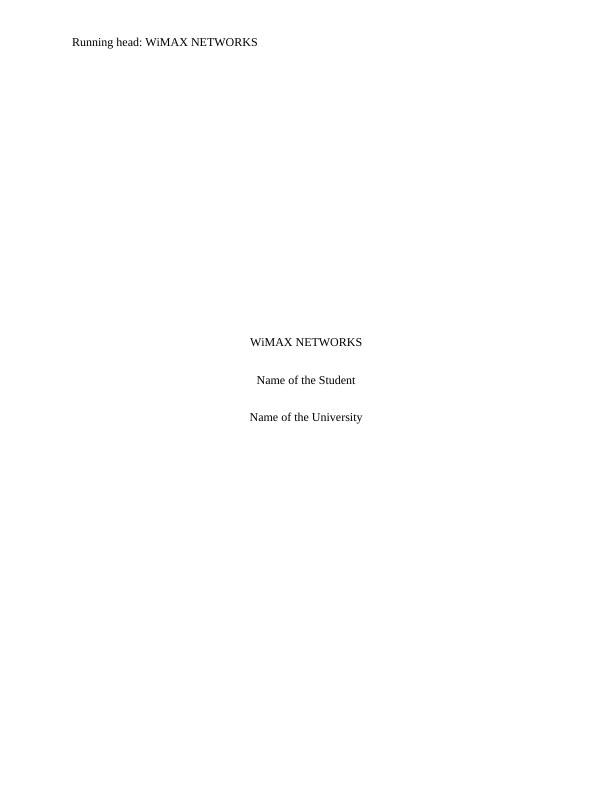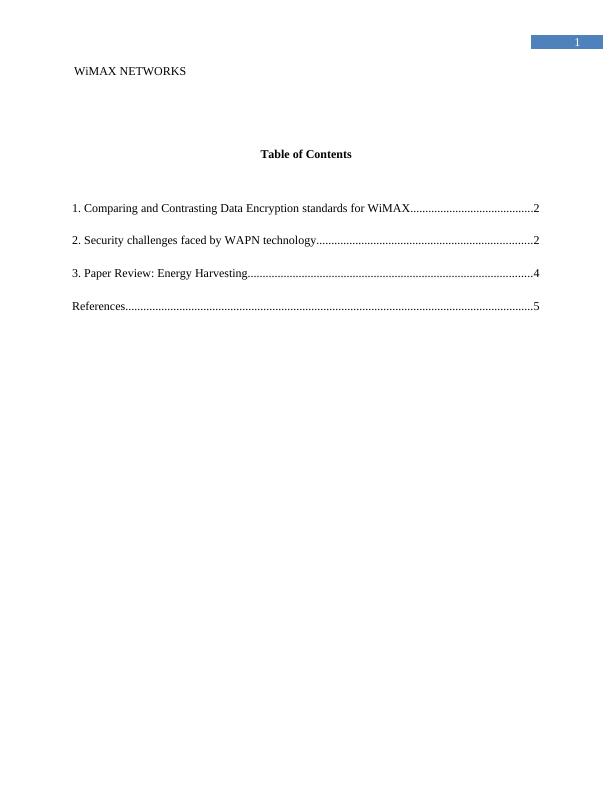Comparing and Contrasting Data Encryption Standards for WiMAX WiMAX
Added on 2020-04-07
14 Pages1447 Words252 Views
Running head: WiMAX NETWORKSWiMAX NETWORKSName of the StudentName of the University

1WiMAX NETWORKSTable of Contents1. Comparing and Contrasting Data Encryption standards for WiMAX.........................................22. Security challenges faced by WAPN technology........................................................................23. Paper Review: Energy Harvesting...............................................................................................4References........................................................................................................................................5

2WiMAX NETWORKS1. Comparing and Contrasting Data Encryption standards for WiMAXWiMAX or Worldwide Interoperability for Microwave Access is a union of theorganizations developing and manufacturing wireless gadgets for the improvement of IEEE802.16 standards for networks like the Broadband Wireless Access (BWA). WiMAX is a 4Gnetworking system and has Wireless Wide Area network (WAN) which covers the area as sameas DSL lines (Ahmad & Ismail, 2016). Wires 3DES (Data Encryption Standard) and AES(Advanced Encryption Standard) are used by the WiMAX for the encryption of data transferredon the network system. Three different keys have been used by this 3DES for data encryption.Each data length is about 56 bit. The encryption keys of 128-bit, 192-bits and 256-bits aregenerally supported by the AES. AES has been denoted as a very popular algorithm that hasbeen built from CCMP. 3DES has a much slower process of encryption than AES. AdvancedEncryption standard thus has much easier process to implement by using less memory. Though,AES does not need dedicated processors on the board such as the BS. But there is also a risk ofAES for not being used by every end-user terminals. At first this helps in considering the factthat the 3DES may remain an important encryption tool over the WiMAX network, even in thepresence of AES (Bahl, Sharma & Verma2012).2. Security challenges faced by WAPN technologyThere are several kinds of WAPN technologies that has been implemented over thenetwork, but two most commonly used WAPN technologies are the Bluetooth and the ZigBeenetwork. Both of these technologies face similar difficulty, as the security issues has been facedby the wireless technology.Security challenges faced by Bluetooth technology are listed below:

3WiMAX NETWORKSEavesdropping: In this process the attacker is able to sniff the air of the transmissiontaken place by the Bluetooth and thus exploits the right vulnerability, reads or listens tothe information (Dadhich, Narang & Yadav, 2012). Bluesnarfing: In this process the attacker can pair to another device and once the devicehas been paired, accessibility gets easy so thus stealing of data from the Bluetooth device.Blue bugging: In this an attacker generally gets the easier access of the remote control ofvarious aspects of the user’s device. Thus sending of messages, outgoing calls and texts,settings change and watching of key presses and screens and many other things must beavoided (Rewagad & Pawar, 2013). Denial of service: DoS is a common data breaching process that puts a barrier betweenthe data and the users, and thus demands for money or unauthorized order to the user forgetting back the accessibility of their data. Blocking the communication, draining thebattery of the device or even crashing the devices is some of the common deeds of DoSattacker. Security challenges faced by ZigBee technology are listed below (Ramsey, Mullins &White, 2012):Sniffing: There is a tendency of the attackers to sniff the improper encryption used in thenetwork system and attack the information of the network.Replay attack: In this the attacker record the approved traffic on the network and plays itlater in a malicious effect.Physical Attacks: The attackers locate the device interference of ZigBee. Hard codedencryption keys which are loaded in the RAM are often employed by radios operating.The devices in the network are disturbed and flashed so there remains a possibility of

End of preview
Want to access all the pages? Upload your documents or become a member.
Related Documents
Overview of WiMAX Networks || Reportlg...
|9
|2120
|112
Introduction to WiMAX Networklg...
|9
|2098
|58
Wireless Networking Concepts Name of the Student Name of the University Authorlg...
|7
|1211
|425
Wireless Communication Standardlg...
|10
|1400
|94
Data Encryption Standards for WIMAXlg...
|19
|1868
|69
Assignment based on Wireless Networking Conceptlg...
|9
|1501
|85
